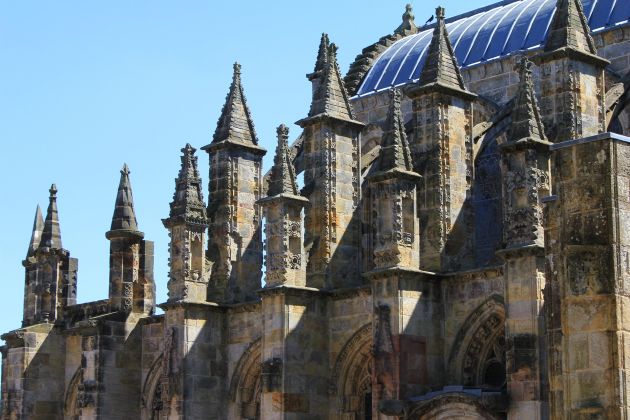The Gothic period spanned a long period of history and its intricate buildings are still captivating today
 Rosslyn Chapel is an example of Gothic Architecture
Rosslyn Chapel is an example of Gothic Architecture
The Gothic style of architecture and art originated in the Middle Ages and was prevalent in Europe between the mid-12th century and the 16th century. It was heavily ornate and conceptual, with its architecture characterised by high buildings, intricate aesthetics, cavernous spaces and expansive walls. It is rooted in French architecture, but can be found all over Europe and even in other continents. The style was originally referred to as “French Work” (Opus Francigenum), and was used extensively by religious bodies, especially the Roman Catholic Church.
The Gothic style was an evolution from Romanesque, which was marked by its many arches, vaulted ceilings and smaller stained glass windows. The Gothic style took these features and exaggerated them, increasing the scale of arches and the magnitude of the windows. The walls of the buildings, however, became thinner and were supported by flying buttresses to assist the architects in achieving structures that appeared to be closer to the heavens.
In the 12th and 13th centuries, advances in engineering enabled architects to design and complete increasingly huge buildings. Features such as the flying buttress, rib vaulted pointed arch – known as the Gothic arch – were used to support very tall buildings and allow in as much natural light as possible. Stained glass windows allowed coloured light into vast interiors.
The Basilica Church of Saint-Denis is regarded as the first truly Gothic building, and marks the styles evolution out of Romanesque. He created a pointed arch, ribbed vault and flying buttresses that supported the large clerestory windows.
These immense Gothic cathedrals were for a long time been the landmark of its town or city, and – in the years before modern tall buildings – was almost always the highest spire in the city. The Gothic churches and cathedrals generally had tall towers. The Basilica of Saint-Denis had two towers of equal height on its west front, a plan that was copied in the plan for Notre-Dame de Paris. In Italy, the towers of the churches were often separate to the main building. External facades were heavily ornamented with sculptures and decorations that depicted scenes from the bible.

The name “Gothic” Architecture came from a derogatory commentary on the style written by Giorgio Vasari in 1550, as the style began to decline. He described the architectural features that came to define Gothic Architecture as “barbarous German style” and blamed “the Goths” for destroying ancient buildings and replacing them with ones in this style.
The greatest number of surviving Gothic architectural buildings are churches. From smaller chapels to the largest Cathedrals.
As a style that spanned such a long time in history, Gothic architecture does of course have a number of different manifestations. It does have some clear characteristics. These are large stained glass windows, ribbed vaults, flying buttresses, ornate embellishments and pointed arches.
Stained glass windows have always been used in places of worship, but are particularly common in the Gothic cathedrals, where they are larger than in most other churches and let in huge amounts of tinted light. These windows were often used to tell stories from the bible in their decorative scenes. Natural light entering through high windows was an important characteristic in the style. This was closely tied to the belief that light was important in holy settings and was linked to divinity.
 Basilique Saint Denis France. Photo by Ninara via Flickr
Basilique Saint Denis France. Photo by Ninara via Flickr
Where the Romanesque style buildings featured wide, round arches, the Gothic churches moved towards an adaptation of Islamic arches: tall and thin arches with pointed peaks. These narrower looking, pointed arches emphasised the height of the buildings.
Ribbed vaults were used as a structural support to enable the height of the buildings with their taller windows. These ribbed arches intersected with barrel vaults that were placed at parallel intervals to support the rounded roof and the height of the buildings.
Flying buttress also support the height of the buildings. These strong structures supported and distributed the weight o the heavy roofs by proving a more solid base. The buttresses allowed the architects to keep the thin walls and large windows that defined the Gothic style.
There are many noteworthy buildings that were built in the Gothic style, including Westminster Abbey, Notre-Dame in Paris, Milan Cathedral, and St Stephen’s Cathedral.
Late Gothic style hit a peak with German churches featuring vaulted halls. Whereas in much of Europe Gothic buildings were fabricated with stone, Italian Gothic used brick and marble instead. Gothic architecture began to decline as Renaissance architecture began to rise in popularity in Italy, France and around Europe.

















